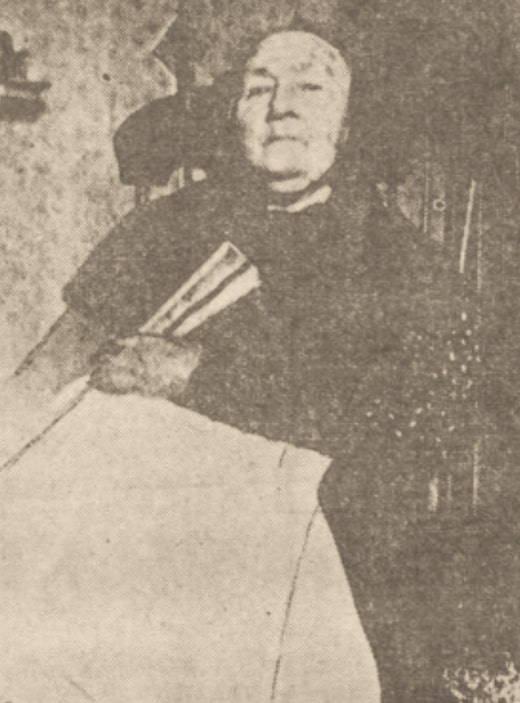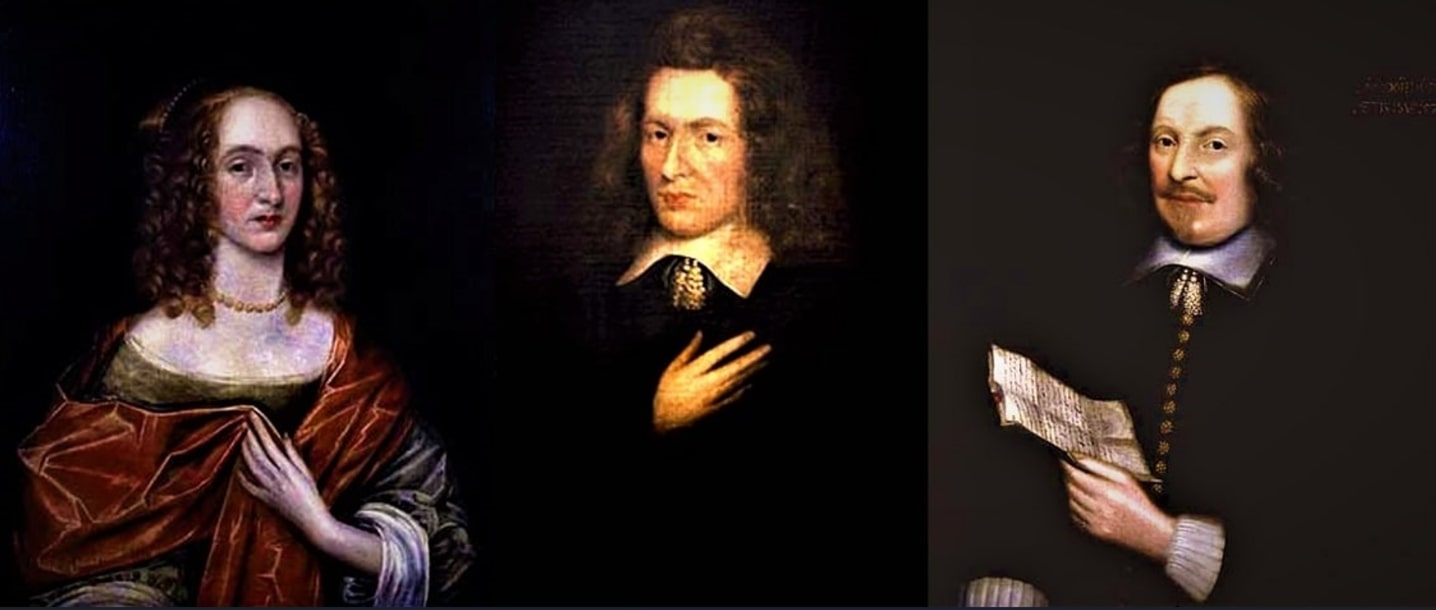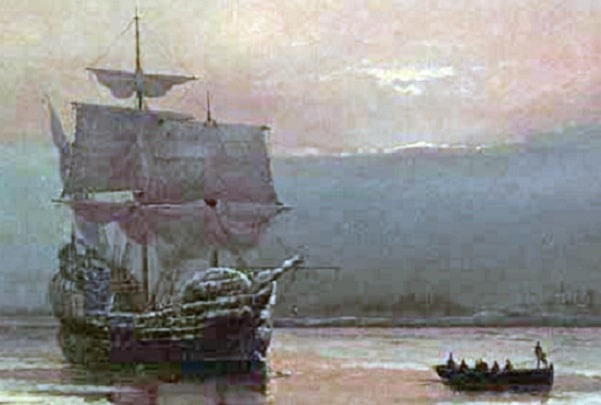Introduction: In this article, Melissa Davenport Berry writes about the remarkable Salome Sellers, who lived to be 108 and had a direct oral history connection to the very first Thanksgiving. Melissa is a genealogist who has a website, americana-archives.com, and a Facebook group, New England Family Genealogy and History.
Today I start my holiday treat mini-series, “Mayflower Descendants: Who’s Who, Thanksgiving Special,” focusing on Salome (Sylvester) Sellers (1800-1909). She was born on Deer Isle, Maine, to Revolutionary War Captain Edward and Deborah (Cushman) Sylvester, and lived more than 108 years!

Salome is a direct descendant of Mayflower passengers Edward Doty, John Howland, Elizabeth Tilley, Edward Winslow, and Isaac Allerton.
Here are portraits (left to right) of: Penelope Pelham (1630-1703); her husband Josiah (aka Josias) Edward Winslow (1623-1680); and his father Mayflower passenger Edward Winslow (1595-1655).

On 23 December 1830 she married Joseph Sellers (1792-1865), son of Charles and Jerusha (Morey) Sellers, and had six children, leaving descendants. She outlived her husband and all her children but her oldest son, William Raynes Sellers (1832-1909).
Before I serve up the main course here are a few nibbles on this prolific character which I found in my research, starting with her obituary published in the Evening Bulletin on Monday, 11 January 1909.
This article reports:
Maines Oldest Women Is Dead at Age of 108
Mrs. Salome Sellers, who lived at Deer Isle, believed to be most venerable daughter of [the] Revolution and New England inhabitant.
…Her mother was Miss Deborah Cushman, a granddaughter of Josiah Winslow, one of the Colonial Governors of Massachusetts, who once owned the farm in Marshfield occupied by Daniel Webster at the time of the latter’s death. Mrs. Seller’s claim to being a “Colonial Dame” was thus well established.
Salome was a real Daughter of the Revolution. She could remember the Embargo Act days of the War of 1812, when she paid 75 cents a yard for “cotton cloth of a very inferior quality.” She was a famous spinner and the oldest member of the Martha Washington Temperence Society. She never wore a corset and stayed clear of spirits.
She attributed her long life to the following rules:
- Never worry, and never miss a chance for a good laugh
- Breath plenty of pure air
- Do plenty of good muscular work
- Be temperate in your habits
- Take as much sleep as nature demands.
Below is Salome’s grave located at Hillside Cemetery, Deer Isle, Hancock County, Maine.
The plaque at the base of Salome’s gravestone lists her national Daughters of the American Revolution number.
I came across this article in a Maine Memory Scrapbook that features Salome, or “Aunt Salome” as she is described here. In a remarkable case of oral history, Salome describes the first Thanksgiving, as told to her by “her Great Grandmother, who in turn heard it told by her Great Grandmother, Mary Allerton Cushman, who was present.” There are also details provided in a 1621 letter.
This article reports:
One thing is for sure, Salome takes deep pride in her Pilgrim ancestors, and she loves to tell of early Thanksgiving, notably the first of which the Pilgrim ancestors partook and the first in New England.
The published record of it is from a letter bearing the date Dec. 11, 1621, to George Morton, which was carried across the Atlantic on the ship Fortune by Robert Cushman, her 5th great grandfather.
You shall understand that in the short time we few have been here, we have built seven dwelling houses, four buildings for the use of the plantation, and have made preparation for several others. We sowed last spring some twenty acres of Indian corn and some six acres of barley and peas. According to the manner of the Indians, we fertilized our ground with herrings, or rather shads, which we have in great abundance and catch with great ease near our homes. Our corn did prove well, and God be praised, we had a good increase of Indian corn and our barley was fairly good, but our peas were not worth gathering. We feared that they were sown too late. They came up very well, and blossomed, but the sun parched them in the blossom.
Our harvest being collected our governor sent four men fowling together so we might rejoice together in a more special way after we had gathered the fruit of our labors. In just one day the hunters killed as much fowl as if their hunting party had been larger.
The fowl fed the company almost a week at which time, among other recreations, we drilled with our fire arms. Many of the Indians joined us including Massasoit, the greatest king, and some ninety of his men. We all entertained and feasted together for three days.
The Indians went out and killed five deer which they brought to the plantation and bestowed on our governor, the captain, and others. And although it is not always as plentiful as it was at that time, yet by the goodness of God we are so far from want that we often wish you could partake of our plenty.
Read more of the letter here: “The First Thanksgiving, Edward Winslow, 1621.”
The inscription on this plaque reads:
This tablet placed beside the gushing water known for many generations as Massasoit’s Spring commemorates the great Indian Sachem Massasoit, “friend of the White man,” ruler of this region when the Pilgrims of the Mayflower landed at Plymouth in the year of our Lord 1620.
At the first Thanksgiving was Salome’s ancestor, her 3rd great grandmother Mary Allerton, who at the time was but 12 years old. Among the crowd was Mary’s future husband Thomas Cushman, who was placed in the care of Governor William Bradford while his father returned to England on the Fortune.
Mary (Allerton) Cushman was the last surviving Mayflower passenger, but never forgot her first Thanksgiving feast in Plymouth. She shared those memories with her children and grandchildren, and the story was passed down directly to Salome.
Stay tuned for more…
Explore over 330 years of newspapers and historical records in GenealogyBank. Discover your family story! Start a 7-Day Free Trial
Note on the header image: “Mayflower in Plymouth Harbor,” by William Halsall, 1882. Credit: Wikimedia Commons.
